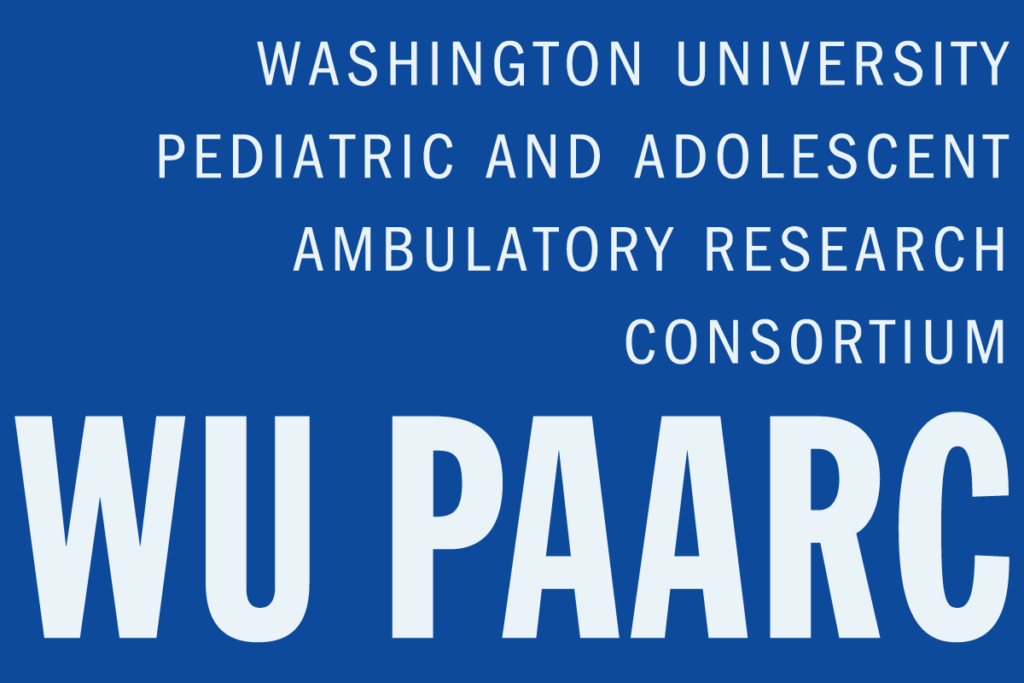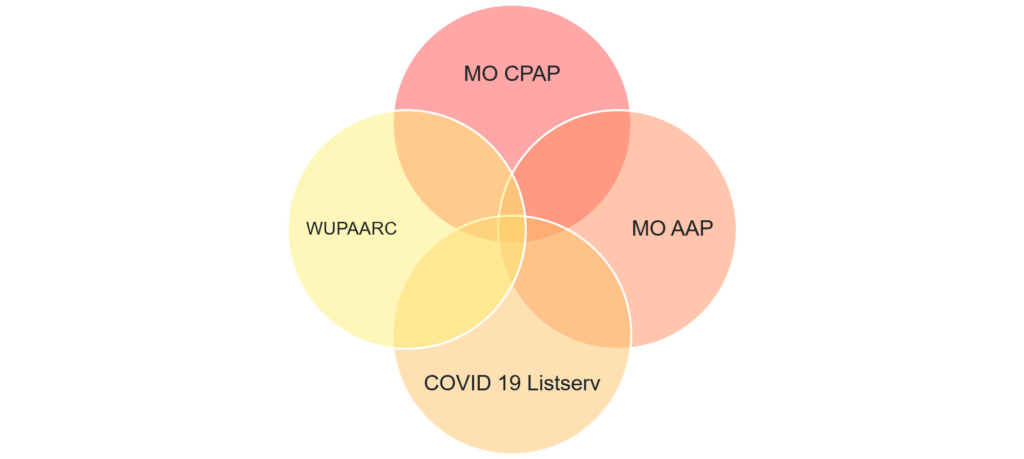The Washington University Pediatric and Adolescent Research Consortium (WU PAARC), a practice-based research network of community pediatric healthcare providers, has been an integral part of the ICTS since the inception of the CTSA program at Washington University in 2007. As a core of the ICTS and a part of the Integrating Special Populations function, WU PAARC continually fosters partnerships between academic institutions, health providers, and the community.
Preparing for the Unexpected
From its inception in 2002, WU PAARC’s infrastructure has grown to actively engage community practitioners in clinical and translational research. In addition to conducting research studies and collaborating with investigators to design and implement studies in the community setting, WU PAARC actively answers patient care questions from practitioners by identifying and disseminating relevant research findings to support evidence-based practice.

These efforts were instrumental when the COVID pandemic hit by providing an existing framework for practitioners to engage and communicate in real-time. “WU PAARC ‘s collaborations over the years provided the necessary infrastructure for sharing information when COVID hit,” reflects Jane Garbutt, MB, ChB, a professor of medicine at Washington University School of Medicine, WU PAARC medical director, and ICTS Integrating Special Populations co-lead. “This existing network was truly a communication catalyst in a time of great need.”
“WU PAARC ‘s collaborations over the years provided the necessary infrastructure for sharing information when COVID hit. This existing network was truly a communication catalyst in a time of great need.”
Jane Garbutt, MB, ChB, a professor of medicine at Washington University School of Medicine, WU PAARC medical director, and ICTS Integrating Special Populations co-lead
WU PAARC reacts to COVID
In the early days of the pandemic, members turned immediately to WU PAARC with questions regarding COVID and their pediatric patients. Jason Newland, MD, MEd, a professor of pediatrics, infectious diseases at Washington University School of Medicine, remembers it well. “On March 17, 2020, several WU PAARC pediatricians contacted me with COVID-specific questions. By the end of that week, we tapped the WU PAARC resources to create a listserv specific to COVID and we were fielding questions around the clock.”
This listserv, managed by Cindy Terrill, a research coordinator that works with Newland and a team of academic pediatric infectious diseases experts, was immediately responding in real-time to primary care providers with information on everything from testing to PPE to office safety procedures. More practitioners joined and the St. Louis Regional Pediatric Learning Collaborative was organized in March of 2020 comprised of pediatric primary care providers (PCPs) and infectious diseases specialists from a diverse group of pediatric practices and academic institutions across the area.
“The Collaborative was born out of the need for practitioners to provide care and give advice about testing to children with very little guidance from anywhere else regarding what to do,” explains Garbutt. “Many of these community physicians had existing relationships with WU PAARC so it was natural for them to reach out to us for help and support.”
Collaborative member and pediatrician Elizabeth Harrison, MD, with Forest Park Pediatrics, a Washington University Clinical Associates practice, echoes how WU PAARC and the Collaborative filled a void at the onset of the pandemic. “The purpose of the collaborative and the listserv was to not only allow providers to ask questions but to provide for information sharing. It was incredibly helpful to have a structure to communicate with other St. Louis area pediatricians so that we could share ideas and align our approach to COVID and kids.”
Collaborative drives research
With the Collaborative underway, WU PAARC saw the opportunity to rapidly collect data to help members deliver optimal care during the pandemic. Over a four-month period, from June to October 2020, 95 primary care providers from 26 practices across the greater St. Louis area participated in data collection, sharing data on over 2,000 children who presented with COVID-like symptoms. The data was collected prospectively using a 1-page form as participating primary care providers spanned various health systems with varying electronic health records. Data was periodically shared with the Collaborative members and a description of the project, “Collaborating to Advocate in Primary Care for Children during COVID-19”, was eventually published in the journal Pediatrics in September 2021.
Harrison, involved with the Collaborative from the onset of the pandemic, joined as an author on the manuscript. “Going into it (the local data collection), we didn’t know what the transmission dynamics would be among kids. We found that being in school or daycare didn’t increase the child’s chances of being positive with COVID. This information subsequently proved critical in driving efforts for access to testing, contact tracing, and safe in-person school.”
Going into it (the local data collection), we didn’t know what the transmission dynamics would be among kids. We found that being in school or daycare didn’t increase the child’s chances of being positive with COVID. This information subsequently proved critical in driving efforts for access to testing, contact tracing, and safe in-person school.”
Collaborative member and pediatrician Elizabeth Harrison, MD, with Forest Park Pediatrics, a Washington University Clinical Associates practice
After four months of collection, the data was summarized in an action sheet that was also shared with area school boards and congressional representatives. This action sheet was particularly critical as the pandemic progressed due to the educational, mental health, and economic consequences of prolonged school closures were taking a toll on children. St. Louis area school district leaders were citing the Collaborative and referencing the action sheet when making decisions about school openings.
Collaborative provides needed resources
The Collaborative worked quickly to respond to timely topics and needs of the members during the pandemic. Early on, when COVID testing availability was limited, providers were concerned about the inability to distinguish COVID-19 from other common childhood infections. So the Collaborative helped develop a clinical testing algorithm based on CDC recommendations at the time. According to Garbutt, “Physicians were trying to triage kids that were presenting with symptoms of COVID-19 on their own. So, to have the Collaborative working collectively on a testing algorithm was reassuring.”

The listserv continued to deliver up-to-the-minute information and over time broadened to deliver additional resources, including webinars. The webinars covered a variety of clinical topics related to COVID-19 and eventually expanded to include mental health as the pandemic progressed and research showed adolescents in need of mental health services. Katie Plax, MD, professor of pediatrics and director of the Division of Adolescent Medicine at Washington University School of Medicine in St. Louis, delivered webinars covering suicide screening and patients presenting with anxiety or depression. In addition, WU PAARC fostered collaboration with the Missouri Child Psychiatry Access Project (MO-CPAP) and the Missouri chapter of the American Academy of Pediatrics (MO-APP). MO-CPAP provided telephone support from licensed psychiatrists to primary care providers caring for patients with mental health conditions. MO-AAP provided disease-specific education including management of patients with suicidal ideation.
Collaborative Fosters Advocacy
Inadvertently, findings from the data collection and the listserv communication were a catalyst for local advocacy during the pandemic. Members from the Collaborative worked together to support increased access to testing, contact tracing and safe in-person school by reaching out to local civic and educational leadership.
Plax, Newland and other Collaborative members communicated directly with local politicians, advocating to two St. Louis Congressional representatives for more rapid use of the Coronavirus Aid, Relief and Economic Security (CARES) Act funds to expand SARS-CoV-2 testing and contact tracing. Members also provided advice and resources to school boards and superintendents and worked to establish relationships with local educational associations like Education Plus.
“By providing ways to interact with pediatric professionals in meaningful ways, we have built relationships that have led to greater pediatric representation in workgroups with school superintendents and greater collaboration with the St. Louis metro-wide COVID-19 task force.”
Katie Plax, MD, professor of pediatrics and director of the Division of Adolescent Medicine at Washington University School of Medicine in St. Louis
Plax attributes the initial WU PAARC infrastructure for encouraging this interaction. “By providing ways to interact with pediatric professionals in meaningful ways, we have built relationships that have led to greater pediatric representation in workgroups with school superintendents and greater collaboration with the St. Louis metro-wide COVID-19 task force.”
Future of the Collaborative
The Collaborative has developed into a well-established and trusted network within the St. Louis pediatric community. The listserv now reaches over 400 members and continues to provide a forum for providers to ask questions and share information on COVID-related topics. Advocacy efforts have positioned the Collaborative as a go-to resource for local school districts and regional civic organizations.
Other medical institutions across the country have reached out to WU PAARC to learn more. “The development of the Collaborative may have been a COVID-unique response to a critical need,” says Garbutt. “But this is a model that is sharable and adaptable anywhere.”
Newland reflects on what the Collaborative was able to accomplish. “We developed something truly collaborative across many practices and healthcare systems. We are part of the same group doing the same thing. The hope is that this collaboration will continue to help in providing the best care within St. Louis and surrounding communities in the future.”